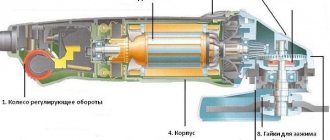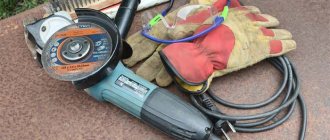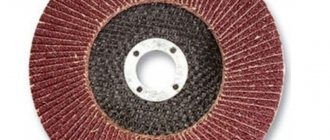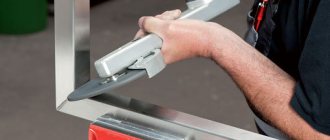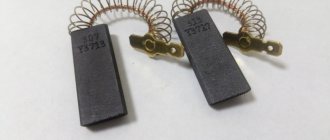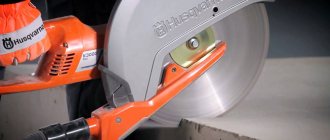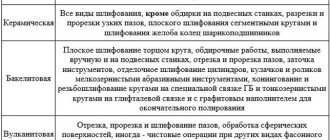The variety of work performed with the help of grinders is largely ensured by the wide range of tools that work with them.
For each standard size angle grinder, you can always select consumables that correspond to the characteristics and dimensions. One of the parameters that determines the capabilities of an angle grinder is the maximum diameter of the disk that is installed on it. It determines the speed, engine power and torque. The choice of disk size is closely related to the nature of the work performed by the grinder.
Types of circles
The circles (disks) of grinders differ according to the following indicators:
- work performed that determines the purpose of the tool;
- composition of the material;
- dimensions.
Technological features
The necessary processing technology is provided by the following consumables.
- — Cutting wheels. Mainly used for processing metals, less often for other types of materials.
- — Grinding wheels. Different designs allow you to perform both roughing or cleaning, and bringing the surface roughness to the desired condition.
- — Polishing discs and attachments. Bring the surface to a shine using felt or other fabric with similar properties.
By material
The operating modes are influenced by the material component from which the tool is made.
- — Abrasive disc. The basis that served for the manufacture of the tool is the abrasive material itself, a binder, for example, bakelite and various fillers. Mainly used for metal processing.
- — Diamond wheel (with diamond coating). With its help, you can process materials of any strength (various types of stone, ceramics, quartz glass and many other similar ones consisting of solid fractions).
Dimensions
The main classification criterion here is the diameter of the disc. The depth of the cut depends on its size (it is approximately a quarter of the diameter). The functionality of an angle grinder is determined by the size of the tool: a small diameter makes it possible to process a light angle grinder in hard-to-reach places, while a larger size angle grinder with greater productivity will be difficult and unsafe to hold “in weight”.
Operating principle and scope
An angle grinder is an electric hand tool that is designed for cutting, sanding and grinding materials such as various types of stone, including concrete, metal, wood and others. The construction of an angle grinder is not particularly complicated. However, it is necessary to navigate this issue in order to be able to carry out repairs or preventive cleaning yourself. The durable plastic case contains the following basic elements :
- Speed control wheel;
- Engine;
- Start button
- Frame;
- Quick disk replacement button:
- Safety coupling;
- Protective cover;
- Working disk clamp nut;
- Gear housing;
The principle of operation itself comes down to the conversion of torque, which comes from a spindle connected to the engine via a gear drive. It is to the spindle that various attachments necessary for this or that type of work are attached. The body of the tool is made of high-strength plastic that can withstand impacts. Simply by using different types of attachments, or rather, different types of abrasive wheels, you can perform completely different tasks, which significantly increases the scope of application of this tool.
The grinder is used when necessary:
- Trim or cut out tiles;
- Cut metal sheets or rods;
- Cut grooves in a brick or concrete wall for laying electrical wiring or water pipes;
- Remove rust from a car body or a layer of old paint;
- Sand wooden or metal surfaces to a high degree of smoothness;
- Clean the welds;
- Dull sharp edges with chamfers.
Marking
The choice of the right tool is facilitated by the presence of markings. It contains the technical parameters of consumables in encrypted form. For example, this is what an alphanumeric set of markings for a cutting disc looks like, produced by a Russian manufacturer:
- — The image shows the tool manufacturer — Luga Abrasive Plant (Luga, Leningrad Region).
- — Tool name:
- cutting wheel - in Russian;
- cut –off – wheel – in English translation.
- — Purpose: for processing steel (inscriptions “steel”, “steel” on the circle).
- — The dimensions of the circle are indicated (outer diameter x thickness x bore diameter):
- in mm – 200 x 2.5 x 22.23;
- in inches – 8”x 1/10”x 7/8”;
- digital designation "41". This is a characteristic of the design of the circle - here it is flat.
- — The circle is designed for 7650 rpm, while the maximum peripheral speed should not exceed 80 m/s.
- — Technical parameters of the wheel material are determined from the designation “A 30 S BF”, where:
- A – means that the abrasive is based on white electrocorundum, which is specifically used for metal processing;
- 30 – abrasive grain size, here it is average;
- S – hardness of the circle, here the circle is hard;
- BF - denotes the type of bond, here synthetic resins with glass fiber reinforcement.
- — Rules for safe work in the form of signs indicating the required action.
- - GOST 21963 - 2002, GOST R 52588 - 2011, EN 12413 - Russian and European regulatory documents to which this tool complies.
The marking of a foreign manufacturer of tools for angle grinders is as follows:
- — Tools under the NORTON VULKAN brand are produced by the Saint Gobain corporation, headquartered in France.
- —The purpose of the cutting disc (the company produces only such a tool for angle grinders) for processing steel (in addition, for visualization purposes, the label for wheels intended for metal processing is blue) is duplicated in several languages.
- — The circle is designed for 12250 rpm with a maximum peripheral speed of 80 m/s.
- — The dimensions are the same as on the Russian disk - in mm and inches.
- — The digital designation “41” has been added to the technical parameters of “A60S – BF41”. This is a characteristic of the design of the circle - here it is flat.
- — Methods of safe work must be indicated.
- — The regulatory documents to which the instrument complies are issued by the European Union.
What are the sizes of wheels for angle grinders Bosch, Interskol and more?
Almost all large companies produce grinders covering the maximum number of works - from household to industrial designs. Each type has its own tool size. In addition to the production of angle grinders, such manufacturers (Bosch, Metabo, Interskol and others) have mastered the parallel production of consumables. They select a special composition and standard size of consumables in order to maximize the operating efficiency of the specific model they produce.
Outer and bore diameter, maximum and minimum value
The most popular range of angle grinder sizes consists of the following values.
External diameter . The most preferred sizes are: 115 mm, 125 mm, 150 mm, 180 mm, 200 mm and 230 mm. In rare cases, to perform, for example, jewelry work with small parts, portable battery-powered angle grinders with diameters of 76 mm or 100 mm are used.
The minimum diameter of 115 mm is used for simple work in the form of processing hard-to-reach surfaces in the household. Anglers with a circle with a diameter of 125 mm have greater ability to perform various household works.
The diameter of 230 mm is used in the professional context of angle grinders for large volumes of work, for example, in construction. Circles with a diameter of more than 230 mm are installed on stationary equipment.
Thickness _ Cutting wheels are available in thicknesses from 0.8 mm to 5.0 mm. Moreover, a larger diameter should have a circle with a correspondingly greater thickness.
You should know! A thin disc is easy to cut, but it is also more likely to break.
Landing diameter . The standard mounting diameter for angle grinder consumables is 22.23 mm. In the vast majority of cases, it is the same for all disk sizes. It is rare to find mounting diameters of 10 mm, 13 mm, 16 mm due to the limited use of angle grinders with a diameter smaller than 100 mm. A 32 mm bore diameter is used with circles of 300 mm and larger on stationary equipment.
For large, medium and small angle grinders
The power classification into small, medium and large is closely related to dimensions and weight. The greater the power, the greater the weight and overall dimensions.
So, for example, grinders with disks of 115 mm - 125 mm and a power of 0.6 kW to 1.2 kW are classified as small equipment.
Angler grinders with discs of 150 mm - 180 mm and a power of up to 2.0 kW belong to the middle class of such equipment.
Professional angle grinders with a power of up to 3.0 kW and a disc diameter of 230 mm conventionally belong to large angle grinders.
Main characteristics of the tool
When you have decided exactly what size tool you need, you can proceed to selecting according to the following parameters:
- The power of an angle grinder is the main indicator of the tool’s performance. The possible power range varies from 0.5 to 2.7 kW, and the increase in power is not directly proportional to the diameter of the working disk. The performance indicator should be chosen according to the same principle as the size - depending on the degree of complexity of the work to be done and its duration. It is clear that using the maximum diameter of the working circle, it is necessary to choose models with a power rating of about 2 kW in order to ensure high rotation speed and increase continuous operation time. But even for small tools with a minimum disc diameter, high power is sometimes needed, especially if you have to continuously grind hard welds for several hours. A small tool with a power rating of 0.5-0.9 kW is considered household and is quite suitable for a small amount of work that does not involve lengthy cutting of pipes or grinding of concrete surfaces. For heavier work, models with a power of 1 to 1.5 kW, which are classified as professional, are suitable. For construction work, it is preferable to use grinders with a power of 1.3 to 2.7 kW.
- Rotational speed The angle grinder ranges from 6000 to 15000 rpm. It is believed that the higher this indicator, the faster you can perform grinding work or clean the surface from rust and other contaminants. In practice, this indicator for each tool is selected individually depending on its weight and is optimal. The only thing you need to know is that the angular speed of rotation depends on the diameter of the working disk. Therefore, for large grinders it is preferable to have a speed control function. When erasing the working edge, this indicator must be reduced, thereby normalizing the speed of angular rotation. For domestic use, a tool with a minimum speed of 6000 rpm is sufficient. If there is construction ahead or work that includes polishing wooden surfaces or making wooden fencing, you will need a model with an indicator of 7000-11000 rpm. For cleaning car bodies and other metal surfaces, choose a tool with a speed of 15,000 rpm or more. These can often be seen at service stations.
- The weight of the tool determines the duration of the work. Don't forget that working puts stress on your arms and back. The lightest tools, whose weight starts from 1.2 kg, are suitable for daily work lasting no more than 4 hours. Medium grinders weighing from 3 to 4 kg are suitable for work for 2-3 hours every day. For heavy work, it is necessary to choose larger models that will cope with the task faster and do not require much effort from the operator. Their weight is 6-9 kg.
- Number of handles. Grinders can be one-handed or two-handed. This immediately catches your eye when visiting specialized stores. All models have a main handle, which is screwed into the spindle itself and can be rearranged on different sides of the body. This makes working with the tool equally convenient for both right-handers and left-handers. The second handle is either the body itself or an additional handle at the end. This makes it possible to hold the tool with both hands if necessary. The choice of the number of handles is again based on the nature of the work to be done. It will be equally convenient to carry out cutting work with a tool with one handle or with two, but it is dangerous to perform grinding work with a one-handed tool. During operation, the grinder can skid strongly and even a physically strong person will have difficulty holding it. Therefore, when choosing powerful models for grinding, look only at two-handed ones. Grinders for fine grinding of low power can also be one-handed. The main handle should preferably have finger protection for large instruments and an extension at the top for small ones. This will prevent the tool from slipping out of tired or sweaty hands. The auxiliary handle should be mushroom-shaped and ideally be able to twist in several positions. This will make working with the grinder as convenient as possible. Both handles must have a rubberized coating.
- or capacity . Gasoline models have a tank volume of 0.7 to 1.5 liters. If you have the opportunity to carry an additional canister of fuel with you, then this indicator does not matter. Cordless angle grinders have a battery capacity of 2-4 A/h. Thanks to this, the spindle rotation speed reaches up to 11,000 rpm. Accordingly, the larger the capacity, the longer the operating time of the tool. For short-term work, the minimum indicator is sufficient.
- Air pressure and speed – for pneumatic models. Speed is important in maintaining a high RPM. This figure reaches from 100 to 540 liters/min. The larger the disc diameter, the higher the feed speed should be. The pressure reaches from 6 to 6.5 atmospheres.
For metal, concrete, wood and other materials
To effectively process any material, it is important to choose the right power so that it matches the diameter of the tool and its thickness. In addition, the consumable must have suitable characteristics for processing a specific type of workpiece material.
The main difference between discs for steel, cast iron, and non-ferrous metals is in the composition of the fillers. To process alloy steels, a very strong additive is added to the disc material that can overcome the resistance of alloy steel. When processing non-ferrous metals, on the contrary, a soft filler is added, which works effectively when processing viscous materials.
Disc for aluminum
To process concrete (tiles, paving slabs), diamond discs are used (actually, these are metal circles coated with diamond).
Tile disc
It is not recommended to process wood with an angle grinder due to the high risk of injury. If such a need nevertheless arises, then the best option would be a grinder with a disk with a diameter of 125 mm. As a working tool, special angle grinder discs for wood should be used.
Wood disc
Useful additional features
More expensive models are equipped with a number of additional features. For example:
- Case It will be very useful if you plan to frequently transport the instrument, or simply for storage and protection from dust and accidental impacts. The grinder must be securely fixed in special recesses. The case can accommodate all the necessary keys and disks.
- soft start system allows you to minimize the load on the engine. When you turn on the tool, the rotation speed will be minimal, gradually increasing. This will protect the internal elements of the gearbox from a sharp impact and from biting the disk in a hard surface. Accordingly, such a tool is easier and more convenient to use.
- Locking the start button also makes work much easier. There is no need to constantly hold the power button pressed, which always quickly tires your hands. Using a small additional button located next to the trigger, you can lock it in the on position.
- Adjustment of disk rotation speed - this function is present in expensive professional models. You can independently set the required rotation speed depending on the work being performed and the diameter of the working disk. This will eliminate the need to purchase multiple tools. But if you do not have the skills to work with an angle grinder, difficulties may arise in independently selecting modes, and the end result will not live up to expectations. You may end up with crooked cuts and other troubles.
- Stabilization of the speed depending on the load on the disk. This function is useful regardless of the user’s skills. The tool automatically selects the optimal rotation speed and optimizes the work process. It is very useful when working with heterogeneous materials that have a soft outer coating and a hard core or vice versa. The electronics recognizes the load change and instantly adjusts the speed.
- Dust protection is very important when working on concrete surfaces. The gearbox and shaft will be reliably protected from the ingress of small abrasive particles. The service life of the grinder depends on this. Models with this function are very expensive, so if you are not involved in construction, then at home you can do without it.
- Automatic disk balancing is inherent in very high-quality instruments. The point is that angle grinders smooth out the runout that occurs when the working edge of the disk is unevenly worn. This is very useful for polishing work. You will notice the difference in working with the tool with and without this function within an hour.
- The ability to connect a construction vacuum cleaner makes work more comfortable and allows less pollution of the surrounding space, the tool itself, and the worker’s respiratory tract. This is an alternative to the built-in dust protection function at a more affordable price.
- Automatic power outage will be useful during power outages. If the light goes out during operation, the machine will work, turning off the power to the angle grinder, and it will not start rotating when the power supply is restored.
How to choose
The main criterion for choosing the disk size will be the nature of the work performed. In the household, these will be circles of smaller diameters; in a production environment, a tool of large diameter (230 mm) is used.
In addition to the dimensional characteristics, you should carefully check the compliance of the disc material with the material of the workpiece being processed.
Another determining factor is the power of the grinder. It is directly related to the weight and overall characteristics of an angle grinder. With approximately the same characteristics, preference should be given to a lighter specimen.
How to replace
The grinder disc is a consumable item. Therefore, it has to be changed frequently. There is a simple algorithm in which an important role is played by the original design of the key supplied to the consumer along with the grinder.
- — The protruding rods of a special key are installed in the grooves of the fastening nut.
- — At the same time, press the lock button located on the gearbox housing. It will lock the rotor from turning.
- — Turn the key counterclockwise to release the fasteners of the worn disk.
- — The old disk is replaced with a new one of the same technical characteristics and size. The new disk is installed with the markings facing out to remind you of the disk parameters and for other good reasons (see explanation in the video above).
- — The fastening nut is first tightened by hand and finally tightened with a special wrench.
The Bulgarian is ready to continue fulfilling its functional purpose.
Stone discs
Stone cutting discs, also known as diamond discs, are used for cutting all types of stones. There are several types of discs with applied diamonds.
- Solid Discs - There is a continuous tape on the disc. Diamonds of non-natural, artificial origin are applied along the entire circumference of the tape. The disc is designed for high-precision cutting.
- Segmented discs - The disc has several technological holes or slots, this increases resistance to mechanical and temperature loads.
- This type of drive is more productive. The disc is designed for rough, not precise cutting.
- Turbo discs - To increase mechanical strength, improve heat dissipation and increase cutting speed, the disc has grooves on the sides of the rim. The disc cuts any mineral materials.
- Turbo segmented discs - Discs are characterized by high performance and versatility.
- Diamond blades differ not only in structure, but also in the cutting method. Can be dry cutting and wet cutting.
- Dry cutting - This method provides a more precise cut. But its disadvantage is a large amount of dust. This type of work requires good ventilation.
- Wet cutting - This kind of cutting involves water cooling due to a constant flow of liquid. The disadvantage of such discs may be the bulkiness of special equipment for supplying liquid.
Where can I buy
You can purchase wheels of various types and sizes from employees of companies that sell spare parts and consumables for grinders. Some component suppliers are presented in the corresponding section of our website.
Sections: Disks
Previous article: How to ring the stator of an angle grinder Next article: Rewinding the stator of an angle grinder with your own hands
Advantages and disadvantages
Like any product produced by modern industry, cutting wheels have their own pros and cons. Let's consider only the main ones.
Abrasive consumables
Among the advantages of disks of this type it is worth highlighting:
- during active use the wheel does not become dull;
- cooling occurs naturally due to the porous structure;
- there is a wide range of product items on the market;
- acceptable price;
The disadvantages of abrasive consumables/tools include:
- wear out quickly;
- cutting is accompanied by the appearance of a characteristic, rather strong odor in the surrounding area;
- During the work, sheaves of bright sparks are formed.
Diamond cutting wheels
Such products have the following advantages:
- minimal formation of sparks during the cutting procedure;
- absence of a strong unpleasant burning smell;
- high wear resistance;
- increased cutting accuracy.
Among the disadvantages of diamond-containing cutting wheels, home craftsmen with extensive experience highlight:
- low level of thermal resistance;
- considerable price.
